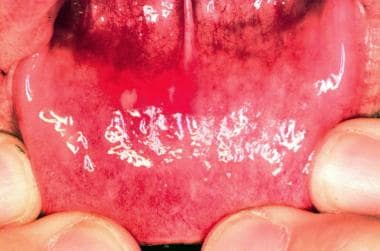Practice Essentials
Hand-foot-and-mouth (HFM) disease is a viral syndrome with a distinct exanthem-enanthem. [1]
This clearly recognizable syndrome is characterized by vesicular lesions on the mouth and an exanthem on the hands and feet (and buttocks) in association with fever. See the image below.
Signs and symptoms
The prodrome is associated with the following:
-
Low-grade fever
-
Malaise
-
Anorexia
-
Abdominal pain
-
Sore mouth
The prodrome precedes the development of oral lesions, followed shortly by skin lesions, primarily on the hands and feet and occasionally on the buttocks.
See Presentation for more detail.
Diagnosis
Physical examination is usually diagnostic, and laboratory studies are typically unnecessary.
See Workup for more detail.
Management
Treatment of HFM disease is primarily supportive.
Standard dosages of antipyretics (eg, acetaminophen, ibuprofen) are recommended on an as-needed basis for fever and analgesia.
See Treatment and Medication for more detail.
Pathophysiology
Hand-foot-and-mouth disease is caused by a group of RNA viruses called enteroviruses. The most commonly implicated enterovirus is coxsackievirus A16. [2] However, coxsackieviruses A5, A9, A10, A16, B1, and B3; human enterovirus 71 (HEV71); as well as herpes simplex viruses (HSV) can cause the illness. Coxsackievirus A6 has been reported as the most common enterovirus identified in seasonal outbreaks of hand-foot-and-mouth disease among children in Europe. [3]
Cases are commonly spread via the fecal-oral or oral-oral route. Respiratory droplet transmission also may occur but is less likely. Typically, the virus seeds the GI tract via the buccal mucosa or the ileum. Over the next 72 hours (accounting for the incubation period), a viremia is established via spread through nearby lymph nodes. [4]
Epidemiology
International statistics
Distribution of this disease is worldwide, with a peak incidence in the summer and fall in temperate climates and with no seasonal pattern in the tropics.
The largest population-based study of the epidemiology of hand, foot, and mouth disease was conducted in China to better inform vaccine and other interventions. Between 2008 and 2012, the Chinese Center for Disease Control and Prevention recorded 7,200,092 probable cases of hand, foot, and mouth disease (annual incidence, 1·2 per 1000 person-years from 2010-12). Mortality (rare in developed countries) and incidence were highest in children aged 12-23 months. [5]
Sex- and age-related demographics
Males and females are affected with equal frequency. Males are more likely to become symptomatically ill.
Hand-foot-and-mouth disease, as well as severe disease complications, are more common among infants and children younger than 5 years.
Prognosis
Patients have an excellent prognosis with full recovery anticipated.
Morbidity/mortality
This illness has, essentially, a full recovery rate. However, HEV71 has been implicated in several large outbreaks in the Far East with severe complications and deaths. Complications are rare, but as with any pruritic rash, a secondary skin infection may occur.
Severe complications may occur when CNS or cardiopulmonary involvement is present. These sequelae include dysphagia, limb weakness, cardiopulmonary failure, and even death. Although death is very rare, it is most often due to pulmonary hemorrhage or edema. A meta-analysis by Ni et al identified the following risk factors associated with fatal HFM disease in children: dyspnea, seizures, lethargy, pneumoedema/pneumorrhagia, and coma. [6]
Enteroviruses as a group are a cause of aseptic meningitis and encephalitis; however, Hand-foot-and-mouth disease is not usually associated with meningitis. [7]
A study that included 1280 stool specimens from pediatric patients hospitalized for treatment of HFMD in China reported that EV71 and CA16 were the most common agents for severe and critical HFM. [8]
Complications
A secondary skin infection is the main complication.
These children can become dehydrated, resulting from decreased oral intake because of the discomfort of the oral lesions.
Rare neurologic and/or cardiopulmonary complications may occur. [9] These are usually associated with HEV71.
Patient Education
Instruct patients' families regarding coxsackievirus contagion.
Instruct patients' families on home monitoring of hydration status and on warning signs of potentially complicating secondary skin infections.
The patient and family must be warned to minimize contact with the patient's oral and respiratory secretions for up to 2 weeks.
Good compulsive handwashing is important to minimize the spread of disease.
The virus may be present in the patient's feces for up to 1 month.
-
The lower lip has an ulcer with an erythematous halo.
-
The tongue has an ulcer with an erythematous halo.
-
A typical cutaneous lesion has an elliptical vesicle surrounded by an erythematous halo. The long axis of the lesion is oriented along the skin lines.










